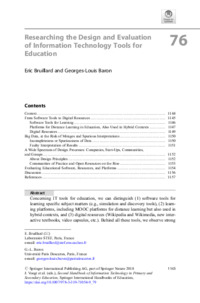Researching the Design and Evaluation of Information Technology Tools for EducationEric Bruillard, Georges-Louis Baron
Zu finden in: Second Handbook of Information Technology in Primary and Secondary Education (Seite 1143 bis 1159), 2018
  |
 |
 Zusammenfassungen
Zusammenfassungen
 Concerning IT tools for education, we can distinguish (1) software tools for learning specific subject matters (e.g., simulation and discovery tools), (2) learning platforms, including MOOC platforms for distance learning but also used in hybrid contexts, and (3) digital resources (Wikipedia and Wikimedia, new interactive textbooks, video capsules, etc.). Behind all these tools, we observe strong tension between the desire to individualize instruction and the intention of offering collaborative usage of general tools, where users have a certain margin of freedom. If the analysis of big data appears as a new Eldorado for education, we have to be aware of incompleteness or spuriousness of data and faulty interpretation of results: number of different types of data (behavior, physiology, etc.) are collected and made accessible, interpreting them is difficult, and much research is still needed. Concerning design processes, a wide spectrum is observed: companies, start-ups, communities, and groups. An interesting link between teacher communities of practice and open educational resources can be underlined. Evaluating education software, resources, and platforms supports an extreme diversity of approaches. But it should include different criteria: functional compliance, interactional conformity, and hedonic quality. Finally, it is important to reaffirm the key role of teachers, helping them to develop their agency in the field of educational resources, empowering them, and accepting them as trusted partners.
Concerning IT tools for education, we can distinguish (1) software tools for learning specific subject matters (e.g., simulation and discovery tools), (2) learning platforms, including MOOC platforms for distance learning but also used in hybrid contexts, and (3) digital resources (Wikipedia and Wikimedia, new interactive textbooks, video capsules, etc.). Behind all these tools, we observe strong tension between the desire to individualize instruction and the intention of offering collaborative usage of general tools, where users have a certain margin of freedom. If the analysis of big data appears as a new Eldorado for education, we have to be aware of incompleteness or spuriousness of data and faulty interpretation of results: number of different types of data (behavior, physiology, etc.) are collected and made accessible, interpreting them is difficult, and much research is still needed. Concerning design processes, a wide spectrum is observed: companies, start-ups, communities, and groups. An interesting link between teacher communities of practice and open educational resources can be underlined. Evaluating education software, resources, and platforms supports an extreme diversity of approaches. But it should include different criteria: functional compliance, interactional conformity, and hedonic quality. Finally, it is important to reaffirm the key role of teachers, helping them to develop their agency in the field of educational resources, empowering them, and accepting them as trusted partners. Dieses Kapitel erwähnt ...
Dieses Kapitel erwähnt ...
 Dieses Kapitel erwähnt vermutlich nicht ...
Dieses Kapitel erwähnt vermutlich nicht ... 
 Nicht erwähnte Begriffe | Buch, Lehrmittelverlag |
 Zitationsgraph
Zitationsgraph
 Zitationsgraph (Beta-Test mit vis.js)
Zitationsgraph (Beta-Test mit vis.js)
 Anderswo finden
Anderswo finden
 Volltext dieses Dokuments
Volltext dieses Dokuments
 |  Researching the Design and Evaluation of Information Technology Tools for Education: Artikel als Volltext bei Springerlink ( Researching the Design and Evaluation of Information Technology Tools for Education: Artikel als Volltext bei Springerlink ( : :  , 317 kByte; , 317 kByte;  : :  ) ) |
 Anderswo suchen
Anderswo suchen 
 Beat und dieses Kapitel
Beat und dieses Kapitel
Beat hat Dieses Kapitel während seiner Zeit am Institut für Medien und Schule (IMS) ins Biblionetz aufgenommen. Beat besitzt kein physisches, aber ein digitales Exemplar. Eine digitale Version ist auf dem Internet verfügbar (s.o.). Es gibt bisher nur wenige Objekte im Biblionetz, die dieses Werk zitieren.










 big data
big data distance learning / Fernunterricht
distance learning / Fernunterricht Open Educational Resources (OER)
Open Educational Resources (OER) Schulbuch / Lehrmittel
Schulbuch / Lehrmittel Wikipedia
Wikipedia






 Biblionetz-History
Biblionetz-History